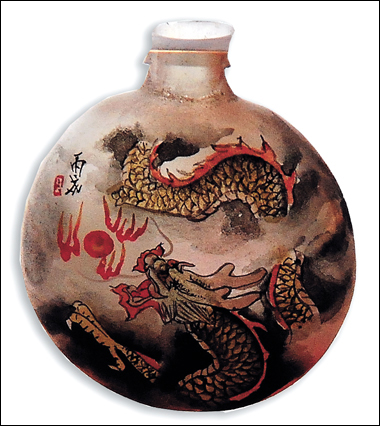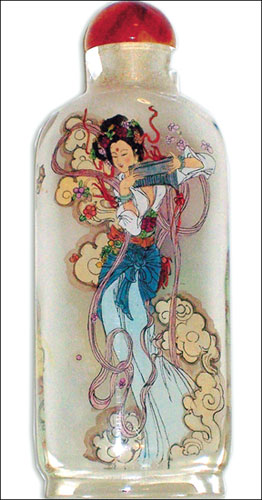
Chinese snuff bottles can be works of art combining carving, miniature interior painting and calligraphy, and the tiny vessels were prized possessions of the Qing Dynasty (1644-1911) emperors.
Snuff is finely powdered tobacco that is inhaled, often mixed with mint, jasmine, camphor, musk or Chinese herbs. The nicotine is absorbed through the mucus membranes.
The taking of snuff became highly ritualized with elegant movements, especially in the imperial court. The snuff bottle stopper usually contained a tiny spoon and a small amount of snuff was placed delicately on the back of the hand, then inhaled, or placed directly in the nostril.
Tobacco, which is native to North America, arrived in China in the late 16th century and was introduced in court by Western missionaries.

At first, tobacco was part of the tribute given to the emperor, due to its relative rarity, but after it was cultivated in the Philippines it became a trade commodity. It was most popular with upper classes but demand for it spread.
Like the native Americans, Chinese believed that tobacco possessed medicinal qualities. Snuff was believed to fight fatigue, help dispel colds and congestion, treat headache and migraine, sinus and tooth pain, relieve throat trouble, cause sweats and treat asthma and constipation. It was considered an important aid to digestion.
Emperor Qianlong of the Qing Dynasty had a special preference for it, but he was more enamored with the bottles themselves - the artistic evolution of the humble snuff box and the Chinese medicine bottle. The craftsmanship reached its apex during his rule.
Emperor Kangxi, grandfather of Qianlong, also appreciated snuff and its glass bottles made in Europe. He invited Western craftsmen to produce them in his palace.
Later Chinese craftsmen fashioned snuff bottles from all kinds of materials - blown glass, crystals, ceramic, jade and other minerals, ivory, coral and so on. Dragons, phoenix, birds and flowers, Tang Dynasty (618-907 AD) poems - all were incorporated.
The tiny bottles were carved, molded, engraved and notably painted delicately on the inside. This was a time-consuming task for artists working through the neck of the tiny transparent bottle.
The interior surface was carefully prepared to hold paint. It was applied with long-handled brushes of delicate hairs.
Snuff bottles became status symbols, avidly collected. When one of the Emperor Qianlong's ministers was sentenced to death for corruption and his estate appropriated, it was found to more than 2,000 snuff bottles of precious materials and superb technique.